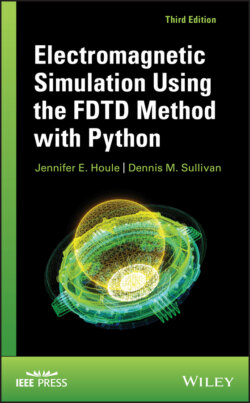Читать книгу Electromagnetic Simulation Using the FDTD Method with Python - Dennis M. Sullivan - Страница 23
1.7 PROPAGATION IN A LOSSY DIELECTRIC MEDIUM
ОглавлениеSo far, we have simulated EM propagation in free space or in simple media that are specified by the relative dielectric constant εr. However, there are many media that also have a loss term specified by the conductivity. This loss term results in the attenuation of the propagating energy.
Once more we will start with the time‐dependent Maxwell’s curl equations, but we will write them in a more general form, which allows us to simulate propagation in media that have conductivity:
(1.19a)
(1.19b)
J, the current density, can also be written as
where σ is the conductivity. Putting this into Eq. (1.19a) and dividing through by the dielectric constant we get
We now revert to our simple one‐dimensional equation:
and make the change of variable in Eq. (1.5), which gives
(1.20a)
(1.20b)
Next, take the finite‐difference approximation for both the temporal and spatial derivatives similar to Eq. (1.3a):
(1.21)
Notice that the last term in Eq. (1.20a) is approximated as the average across two time steps in Eq. (1.21). The tildes were dropped from Eq. (1.21) for simplicity. From Eq. (1.8),
so Eq. (1.21) becomes
or
Figure 1.6 Simulation of a propagating sinusoidal wave striking a lossy dielectric material with a dielectric constant of 4 and a conductivity of 0.04 (S/m). The source is 700 MHz and originates at cell number 5.
From these we can get the computer equations:
(1.22a)
(1.22b)
where
(1.23a)
(1.23b)
(1.23c)
The program fd1d_1_5.py simulates a sinusoidal wave hitting a lossy medium that has a dielectric constant of 4 and a conductivity of 0.04. The pulse is generated at the left side and propagates to the right (Fig. 1.6). Notice that the waveform in the medium is absorbed before it hits the boundary, so we do not have to worry about absorbing boundary conditions.
